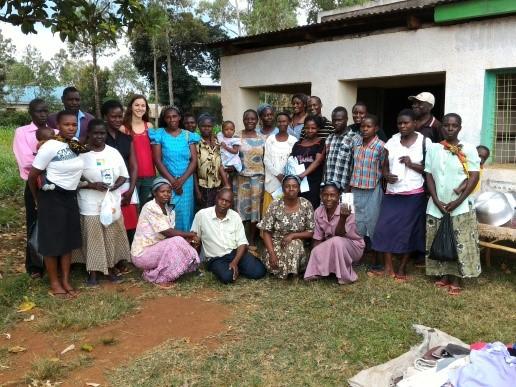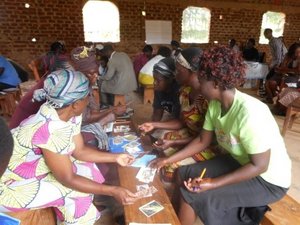Community action for improved nutrition gathers momentum in Kenya

Part 2 of three special reports from Vihiga County, Kenya, where a research initiative is empowering the community to better use available agricultural biodiversity to improve nutrition all year round.
Part 2 of three special reports from Vihiga County, Kenya, where a research initiative is empowering the community to better use available agricultural biodiversity to improve nutrition all year round.
Julia Boedecker, Associate Scientist, Bioversity International, based in Nairobi, has spent two months in Vihiga County, Western Kenya working with local colleagues and partners to carry out six community workshops in five locations. Julia reports on the second phase of the project which focuses on participatory development of interventions to improve diets using agricultural biodiversity.
“Through the workshops I have learnt many new things. Before, I did not know that a diverse diet is important for health”, says Beverlyne Malesi, one of the 180 participants in the community nutrition workshops.
 Once a week Beverlyne comes with her daughter to a church in Masana to attend the workshops, which are facilitated by community health workers, with additional support from local nutrition and agricultural experts. Activities include mediating basic nutrition knowledge and promoting the importance of a diverse diets with participants representing a good cross-section of the community, including female caregivers of young children, farmers, teachers, women’s group leaders, spiritual leaders and village elders.
Once a week Beverlyne comes with her daughter to a church in Masana to attend the workshops, which are facilitated by community health workers, with additional support from local nutrition and agricultural experts. Activities include mediating basic nutrition knowledge and promoting the importance of a diverse diets with participants representing a good cross-section of the community, including female caregivers of young children, farmers, teachers, women’s group leaders, spiritual leaders and village elders.
Vihiga County is rich in agricultural biodiversity but in general, the diets of women and small children in the region are not diverse enough. On average, women consume only four out of ten food groups, while small children consume three out of seven. Stunting is a serious problem – 28% of children are affected. We are also seeing different forms of malnutrition in the caregivers – 8% are underweight while 18% are overweight with 7% classed as obese.
“We have improved eating at home, thanks to the workshops. We never used to eat fruits. As we did not know the importance of fruits we did not buy them on the market. Now we eat at least two types of fruits a day, for example banana and watermelon. My child loves watermelon. I have created a timetable to diversify food consumption at home. The foods I eat today, I try not to eat tomorrow. When I come back from the workshops my neighbours ask me what I have done. I encourage them to eat diversified food,” continues Beverlyne Malesi.
 Raising awareness about the food biodiversity of Vihiga County is another important element of the workshops. This includes discussing the results of a baseline survey on nutrition and agrobiodiversity carried out an earlier stage of the research project.
Raising awareness about the food biodiversity of Vihiga County is another important element of the workshops. This includes discussing the results of a baseline survey on nutrition and agrobiodiversity carried out an earlier stage of the research project.
“I did not know that some plants are actually foods, for example cassava leaves and passion fruit leaves. I also started to plant a vegetable, dania, as I have learned it is important and can also be mixed with other vegetables such as sukuma wiki (kale) or spinach”.
Now that the participants are aware of the importance of dietary diversity and using local agricultural biodiversity for nutrition, the next step has been to encourage the participants to develop their own strategies to diversify diets in their community.
It is very rewarding to see how the participants have changed from passive listeners in the first workshop to active, engaged participants who present their own ideas to each other, share their thoughts and work together on a community action plan to implement interventions that they have identified. Most of the groups have chosen planting of vegetables and/or planting of legumes and poultry-keeping as interventions to diversify diets in their communities.
One important guideline in the development of the action plan is to ensure that as many people as possible in the community are reached by the intervention. To ensure that action goes beyond the workshop participants, the next step will be a kick-off event at each of the five locations to invite everyone in the community to learn about the project, dietary diversity and local agricultural biodiversity in an enjoyable way.
For more information, contact: Julie Boedecker
Read the other two special reports from Vihiga County, Kenya:
Part 1: How communities in Kenya are putting nutritious diversity back on the plate
Part 3: Malezi Bora – Food Biodiversity for Improved Nutrition in Kenya
This research is being carried out in collaboration with the CGIAR Research Program on Agriculture for Nutrition and Health, and the CGIAR Research Program on Humidtropics, and as part of our ‘Healthy Diets from Sustainable Food Systems’ Initiative
Photo 1: Participants at one of the community workshops
Photo 2: Once a week Beverlyne Malesi comes with her daughter to a church in Masana to attend the workshops
Photo 3: Working with food cards to learn about food groups and dietary diversity at a community session
Credit: Bioversity International/J. Boedecker
